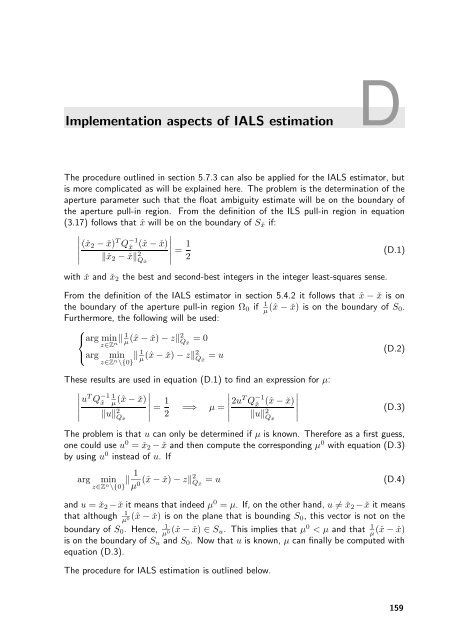The GNSS integer ambiguities: estimation and validation
The GNSS integer ambiguities: estimation and validation
The GNSS integer ambiguities: estimation and validation
You also want an ePaper? Increase the reach of your titles
YUMPU automatically turns print PDFs into web optimized ePapers that Google loves.
Implementation aspects of IALS <strong>estimation</strong> D<br />
<strong>The</strong> procedure outlined in section 5.7.3 can also be applied for the IALS estimator, but<br />
is more complicated as will be explained here. <strong>The</strong> problem is the determination of the<br />
aperture parameter such that the float ambiguity estimate will be on the boundary of<br />
the aperture pull-in region. From the definition of the ILS pull-in region in equation<br />
(3.17) follows that ˆx will be on the boundary of Sˇx if:<br />
<br />
<br />
(ˇx2<br />
− ˇx)<br />
<br />
<br />
T Q −1<br />
<br />
ˆx (ˆx − ˇx)<br />
<br />
<br />
<br />
<br />
ˇx2 − ˇx 2 Qˆx<br />
= 1<br />
2<br />
with ˇx <strong>and</strong> ˇx2 the best <strong>and</strong> second-best <strong>integer</strong>s in the <strong>integer</strong> least-squares sense.<br />
(D.1)<br />
From the definition of the IALS estimator in section 5.4.2 it follows that ˆx − ˇx is on<br />
the boundary of the aperture pull-in region Ω0 if 1<br />
µ (ˆx − ˇx) is on the boundary of S0.<br />
Furthermore, the following will be used:<br />
⎧<br />
1<br />
⎨arg<br />
min<br />
z∈Zn µ<br />
⎩<br />
(ˆx − ˇx) − z2 = 0 Qˆx<br />
1<br />
arg min µ (ˆx − ˇx) − z2 (D.2)<br />
= u Qˆx<br />
z∈Z n \{0}<br />
<strong>The</strong>se results are used in equation (D.1) to find an expression for µ:<br />
<br />
<br />
u<br />
<br />
<br />
T Q −1<br />
ˆx 1<br />
µ (ˆx − ˇx)<br />
<br />
<br />
1<br />
=<br />
2<br />
=⇒<br />
<br />
<br />
2u<br />
µ = <br />
<br />
T Q −1<br />
<br />
ˆx (ˆx − ˇx)<br />
<br />
<br />
<br />
<br />
u 2 Qˆx<br />
u 2 Qˆx<br />
(D.3)<br />
<strong>The</strong> problem is that u can only be determined if µ is known. <strong>The</strong>refore as a first guess,<br />
one could use u 0 = ˇx2 − ˇx <strong>and</strong> then compute the corresponding µ 0 with equation (D.3)<br />
by using u 0 instead of u. If<br />
arg min<br />
z∈Zn 1<br />
<br />
\{0} µ 0 (ˆx − ˇx) − z2Qˆx = u (D.4)<br />
<strong>and</strong> u = ˇx2 − ˇx it means that indeed µ 0 = µ. If, on the other h<strong>and</strong>, u = ˇx2 − ˇx it means<br />
that although 1<br />
µ 0 (ˆx − ˇx) is on the plane that is bounding S0, this vector is not on the<br />
boundary of S0. Hence, 1<br />
µ 0 (ˆx − ˇx) ∈ Su. This implies that µ 0 < µ <strong>and</strong> that 1<br />
µ (ˆx − ˇx)<br />
is on the boundary of Su <strong>and</strong> S0. Now that u is known, µ can finally be computed with<br />
equation (D.3).<br />
<strong>The</strong> procedure for IALS <strong>estimation</strong> is outlined below.<br />
159
















